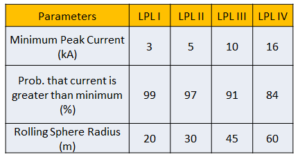
Striking Distance is termed as the shortest distance between a downward leader and a particular structure or object. It depends on the amplitude of the lightning current.
![]()
Where ‘I’ is the minimum peak current.
‘r’ is the striking distance i.e. radius of Rolling Sphere
The minimum values of peak current is given in IS/IEC 62305-1, which is 3kA, 5 kA, 10kA & 16kA for Level I, II, III, IV respectively.
The Striking Distance Approach:
Relation between LPL and Striking Distance: According to the IS/IEC 62305-1, it is said that Level I, II, III & IV offers 99%, 97%, 91% & 84% probability that the Lightning Current may be greater than these levels.

Origin of Rolling Sphere Radius: So, lets take a look how the Rolling Sphere Radius is coming from?
So if we take a quick glance at the last page and look into the formula and put the values of Ip, lets see what we get.
![]()
Now, Lets put Ip as 3 kA as per LPL I.

Case Study:
Again it is to be noted that lightning strikes lesser than 3kA are very rare and they don’t potentially cause any damage to the structure.
Conclusion:
To offer a greater lightning protection level a smaller striking distance (Radius of Rolling Sphere) is needed. The lesser the striking distance, the distance between the air terminal decreases thus increases the capability to intercept lightning strikes of lesser amplitude. In this way we can increase the total percentage of lightning strikes captured.